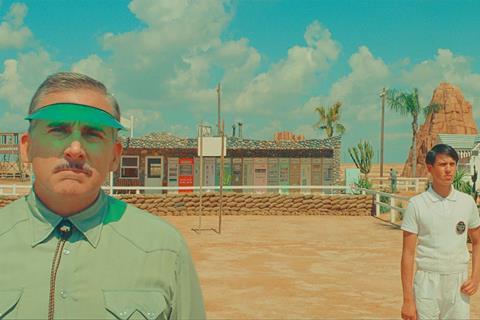
Spain enjoys a long tradition of attracting international productions, and in 2021 Wes Anderson took his Cannes Competition title Asteroid City in Chinchon, 50 kilometres southeast of Madrid, doubling for the US. The introduction of elevated tax breaks came into effect on January 1 is now turbocharging the influx.
Netflix, with its big base just outside Madrid, has brought a number of productions over the past few years. Most recently The Crown shot some of its sixth season in Catalonia and Mallorca, while Charlie Covell’s reimagined Greek mythology series Kaos filmed in Andalusia, Aragon and Madrid. Charlie Brooker’s Black Mirror visited the Canary Islands, as did The Mother, the Netflix feature starring Jennifer Lopez. Spanish director JA Bayona filmed Society Of Snow in Granada’s Sierra Nevada mountains in 2022, telling the real-life story of the Uruguayan plane that crashed in the Andes in 1972 while carrying a Montevideo rugby team to Chile.
MGM/STX’s The Covenant from Guy Ritchie, starring Jake Gyllenhaal, filmed mostly in Zaragoza, while Yash Raj Films’ Bollywood blockbuster Pathaan, directed by Siddharth Anand, shot in Cadiz in Andalusia in 2022.
Now HBO’s House Of The Dragon is preparing to shoot its second season in Spain, having shot parts of the first season in Granada, Caceres, Girona and Biscay in 2021.
The latest boom in international film and TV shoots began in 2015, after Game Of Thrones filmed in Andalusia and a 15% tax rebate for international projects was established. In 2021, Spain’s prime minister Pedro Sanchez introduced a plan to invest $1.75bn (€1.6bn) to ramp up the audiovisual sector between 2021 and 2025.
“This government has done a lot more than any previous one to bring international shoots to Spain, as well as for the internationalisation of Spanish cinema,” says producer Peter Welter Soler from Fresco Film Services, the Barcelona, Lisbon and Malaga-based production services company that has worked on Kaos, season two of Netflix’s Warrior Nun, and Game Of Thrones and House Of The Dragon, among others. “It has improved the incentives and modified the working visa process, making requirements more flexible and streamlining the procedures,” he adds.
The production boom is also helping a generation of local technicians improve their skills, which is benefitting homegrown films, as witnessed by the festival success of Spanish films including Estibaliz Urresola Solaguren’s Berlinale 2023 award winner 20,000 Species Of Bees.
Fernando Victoria de Lecea, a producer at Menakoz Films and also the president of Profilm, the organisation of service providers in Spain, says the sector should not get complacent. “In terms of cost, we are average in Western Europe but expensive if compared with Eastern Europe,” he says.
In the short term, de Lecea suggests the incentives should be tweaked further to “raise the return caps a little more per film and series episodes”. At present, the national incentive allows eligible film and TV productions to receive a rebate of 30% on costs up to $21.7m (€20m) per film and $10.8m (€10m) for any single series episode. De Lecea would like to see the film cap raised to $33m (€30m), as long as it does not exceed 50% of the budget, and to reduce the qualifying minimum local spend from $1.1m (€1m) to $221,000 (€200,000) in the case of series, post-production work and visual effects. “We are very competitive in terms of quality crews, national cinema culture and diversity of settings,” he underlines. Productions apply through a local producer and receive the incentive within six months.
Local knowledge

New York-based Civilian 7 Entertainment went to the Canary Islands for Stuart Gatt’s Catching Dust, attracted by the “terrific tax rebate”, according to company founder Jon Katz. “The film is set in the desert of west Texas. We were amazed when our local team found a spectacular desert valley framed by mountains where we could shoot in 360 degrees,” Katz says. “We faced several weather-related equipment issues, but the local crews, via Volcano Films, were knowledgeable and easy to work with.”
Demand is rocketing, however, and urgent training is required to create a wider pool of highly skilled technical crews, say local producers.
But there is good news for the re‑opening of the Ciudad de la Luz (City of Light) film studios in Alicante. The facility was forced to close in 2012 following a European Commission ruling that upheld complaints from production studios, including Pinewood Studios, that public funds invested in the facility amounted to unfair competition. Its closure left Spain without a facility on the scale of other European studios for a decade.
Ciudad de la Luz is owned by the Valencian government, which originally invested $515m (€470m) and has invested $27.6m (€25m) to update the complex. It now has six soundstages totalling 11,160 square metres, 9,930 square metres of workshops and storage and 29.2 acres of backlot as well as an exterior water tank.
“Filming in Ciudad de la Luz is imminent,” says Antonio Rodes, general director of the studio, with the first project due this May, a French production for a streaming platform, and the second one a Spanish miniseries. “There are several projects that are about to make the final decision to shoot in Alicante, and this allows us to venture that in the second half of the year the studios will be at full capacity,” he adds.
The local economic impact of the studios is estimated to be $930m (€850m) over the next five years.
THE LOWDOWN
European status
Spain is a member of the EU and a participant in the Schengen Area. Its currency is the euro.
Financial incentives
At a national level, there is a tax rebate of 30% on international film and TV productions spending at least $1.1m (€1m) in Spain. For animation and post-production, the minimum expenditure required in Spain is $221,000 (€200,000). The 30% rate is for the first €1m of eligible expenditure, and 25% thereafter. This is capped at $21.7m (€20m) per movie and $10.8m (€10m) for any single series episode since January 1.
There is a 35% tax credit in Navarre (40% for animation and special works), for productions that shoot for at least one week, allowing a maximum tax deduction of up to $5.45m (€5m). Navarre also offers its own regional subsidies and a Cultural Patronage Law.
The Canary Islands offers a 50% tax rebate (reaching 54% under certain conditions) on the first $1.1m (€1m) of expenditure, and 45% after, with a $39.5m (€36m) ceiling in the case of features and $19.8m (€18m) for each series episode (see page 30).
Biscay offers up to 70% tax credit for international and national productions. The maximum percentage will apply to Basque-language productions. Notably, the incentive has no cap at all. Icelandic filmmaker Baltasar Kormakur is lined up to shoot his 17th-century drama and Spain-Iceland co-production Whalemen — At The Ends Of Earth in the region. Full details
- shootinginspain.info/en
- navarrafilmindustry.com/en/come-to-navarra/incentive
- bifilmcommission.com/tax-scheme
- canaryislandsfilm.com/en/incentivos
Infrastructure and crews
The affordable transport network and accommodation services are some of Spain’s major assets, thanks to a well-established tourism industry, not to mention its average 3,000 hours of sun per year.
Major service providers include Babieka Films, Calle Cruzada, El Ranchito, Fresco Film Services, Meñakoz Films, Minded Factory, Nanu Films, Nostromo Pictures, Palma Pictures, Seven Islands Film, sur-film, The Mediapro Studio, Truenorth and Volcano Films, among others.
The soon-to-reopen Ciudad de la Luz Studios in Alicante is a 70-minute flight from Madrid or Barcelona. The high-speed train journey from Madrid takes just over two hours. The studios have six stages: two of which are 2,400 square metres and can be connected — the largest in Spain — and four stages that are 1,600 square metres.
Madrid Content City is the headquarters of Netflix’s European Production Hub, located 25 kilometres from the city centre and launched by Spanish production services company Grupo Secuoya and publishing giant the Planeta Group. The whole complex offers 10 studios with soundstages ranging from 1,200 to 2,000 square metres. Among the facilities is a building that houses up to 23 post-production suites and an auditorium. It is set in Tres Cantos, 30 minutes by car from the capital’s centre.
As for Catalonia, Catalunya Media City is a planned digital hub for the audiovisual and video-games sectors in Sant Adria del Besos, close to Barcelona, which has just been officially approved. The investment is set at around $494m (€450m). The facilities will span 100,000 square metres and will be partially operative in two to three years, according to the Catalan authorities. Also planned is an expansion of Barcelonas Terrassa Parc Audiovisual.
Size matters
A high-speed rail network, 290,000 kilometres of motorway and roads, and around 50 airports allow international crews to travel easily around mainland Spain’s nearly 506,000 square kilometres, including 8,000 kilometres of coastline.
The transport network is also reliable between the mainland and the Canary and Balearic islands, with a regular schedule of flights and ferries.
First person to contact: Teresa Azcona, general manager, Spain Film Commission























No comments yet